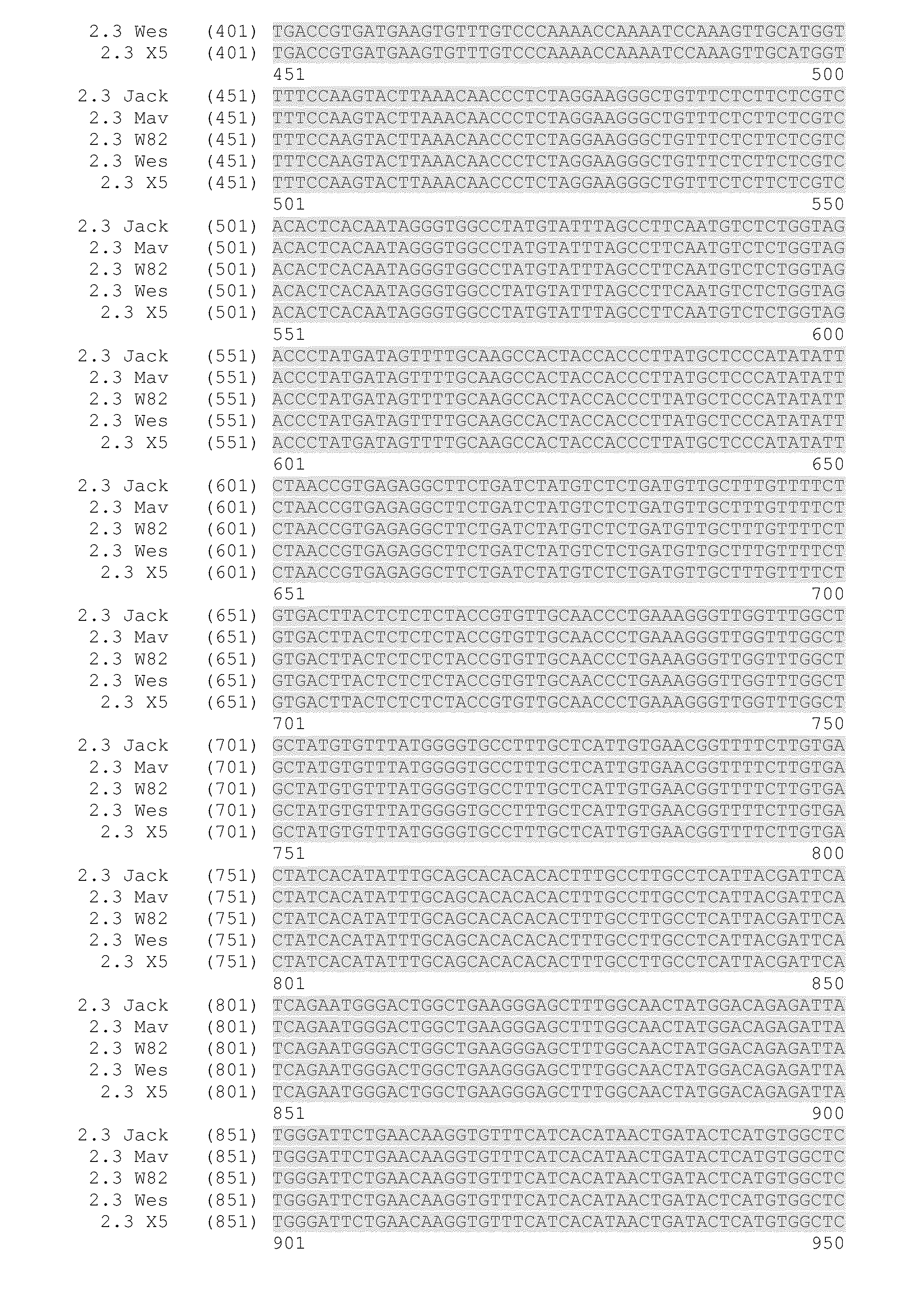Fad2 performance loci and corresponding target site specific binding proteins capable of inducing targeted breaks
a technology of fad2 and target site, which is applied in the field of recombinant plant technology, can solve the problems of inability to control the effect, affecting the expression level of integrated nucleic acids, and affecting or disturbing the normal function of the target region to produce undesirable side effects, so as to achieve the effect of minimal adverse impact on the agronomic performance of the hos
- Summary
- Abstract
- Description
- Claims
- Application Information
AI Technical Summary
Benefits of technology
Problems solved by technology
Method used
Image
Examples
example 1
Sequencing of FAD2 Target Sequences from Five Soybean Culivars
Sequencing Reactions
[0203]Genomic DNA was isolated from soybean tissues. The genomic DNA was isolated and purified from lyophilized embryogenic suspension cells for cultivars X5 and Westag and from young leaves for cultivars Jack, Williams 82 and Maverick. The genomic DNA was extracted using a DNeasy Plant Mini Kit™ (Qiagen; Carlsbad, Calif.) per the manufacturer's protocols.
FAD2 2.3 and 2.6 Genes
[0204]The FAD2 2.3 and FAD2 2.6 genomic DNA sequences were amplified by PCR using primers MA49 (SEQ ID NO:1 caagggttccaaacacaaagcc) and MA51 (SEQ ID NO:2 catcaatacttgttcctgtacc) or MA50 (SEQ ID NO:3 gaagaagcctctctcaagggttc) and MA51. Genomic DNA sequence was obtained for a fragment of approximately bases 40 to 1140 of the 1140 bp gene. PCR reaction conditions were of 1 min at 98° C. for the initial denaturation, then 35 cycles of 30 s at 98° C., 15 s at 60° C., 3 min at 72° C. and a final extension for 5 min at 72° C.
[0205]The re...
example 2
Design of Zinc Finger Binding Domains Specific to FAD2 Genes
[0210]Zinc finger proteins directed against DNA sequences encoding various functional sequences of the FAD2 gene locus were designed as previously described. See, e.g., Urnov et al. (2005) Nature 435:646-651. Exemplary target sequence and recognition helices are shown in Table 1 (target sites) and Table 2 (recognition helix regions designs). Zinc Finger Nuclease (ZFN) target sites were designed to bind target sites of FAD2. The FAD2 zinc finger designs were incorporated into zinc finger expression vectors encoding a protein having at least one finger with a CCHC structure. See, U.S. Patent Publication No. 2008 / 0182332. In particular, the last finger in each protein had a CCHC backbone for the recognition helix. The non-canonical zinc finger-encoding sequences were fused to the nuclease domain of the type IIS restriction enzyme FokI (amino acids 384-579 of the sequence of Wah et al., (1998) Proc. Natl. Acad. Sci. USA 95:1056...
example 3
Zinc Finger Nuclease and Donor Constructs
ZFN Constructs
[0212]Plasmid vectors containing ZFN expression constructs of the exemplary zinc finger nucleases, which were identified using the assay, as described in Example 2, were designed and completed.
[0213]Each zinc finger-encoding sequence was fused to a sequence encoding an opaque-2 nuclear localization signal (Maddaloni et al. (1989) Nuc. Acids Res. 17(18):7532), that was positioned upstream of the zinc finger nuclease. Next, the opaque-2 nuclear localization signal::zinc finger nuclease fusion sequence was paired with the complementary opaque-2 nuclear localization signal::zinc finger nuclease fusion sequence. As such, each construct consisted of a single open reading frame comprised of two opaque-2 nuclear localization signal::zinc finger nuclease fusion sequences separated by the 2A sequence from Thosea asigna virus (Mattion et al. (1996) J. Virol. 70:8124-8127). Expression of the fusion proteins was driven by a relatively strong...
PUM
| Property | Measurement | Unit |
|---|---|---|
| Electrical resistance | aaaaa | aaaaa |
| Nucleic acid sequence | aaaaa | aaaaa |
Abstract
Description
Claims
Application Information
 Login to View More
Login to View More - R&D
- Intellectual Property
- Life Sciences
- Materials
- Tech Scout
- Unparalleled Data Quality
- Higher Quality Content
- 60% Fewer Hallucinations
Browse by: Latest US Patents, China's latest patents, Technical Efficacy Thesaurus, Application Domain, Technology Topic, Popular Technical Reports.
© 2025 PatSnap. All rights reserved.Legal|Privacy policy|Modern Slavery Act Transparency Statement|Sitemap|About US| Contact US: help@patsnap.com



